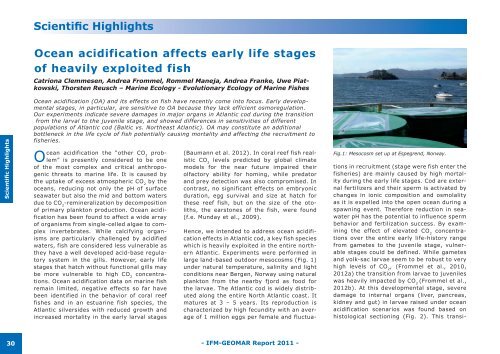Appendices
Appendices
Appendices
Create successful ePaper yourself
Turn your PDF publications into a flip-book with our unique Google optimized e-Paper software.
Scientific Highlights<br />
30<br />
Scientific Highlights<br />
Ocean acidification affects early life stages<br />
of heavily exploited fish<br />
Catriona Clemmesen, Andrea Frommel, Rommel Maneja, Andrea Franke, Uwe Piatkowski,<br />
Thorsten Reusch – Marine Ecology - Evolutionary Ecology of Marine Fishes<br />
Ocean acidification (OA) and its effects on fish have recently come into focus. Early developmental<br />
stages, in particular, are sensitive to OA because they lack efficient osmoregulation.<br />
Our experiments indicate severe damages in major organs in Atlantic cod during the transition<br />
from the larval to the juvenile stage, and showed differences in sensitivities of different<br />
populations of Atlantic cod (Baltic vs. Northeast Atlantic). OA may constitute an additional<br />
bottleneck in the life cycle of fish potentially causing mortality and affecting the recruitment to<br />
fisheries.<br />
Ocean acidification the “other CO2 problem”<br />
is presently considered to be one<br />
of the most complex and critical anthropogenic<br />
threats to marine life. It is caused by<br />
the uptake of excess atmospheric CO by the<br />
2<br />
oceans, reducing not only the pH of surface<br />
seawater but also the mid and bottom waters<br />
due to CO -remineralization by decomposition<br />
2<br />
of primary plankton production. Ocean acidification<br />
has been found to affect a wide array<br />
of organisms from single-celled algae to complex<br />
invertebrates. While calcifying organisms<br />
are particularly challenged by acidified<br />
waters, fish are considered less vulnerable as<br />
they have a well developed acid-base regulatory<br />
system in the gills. However, early life<br />
stages that hatch without functional gills may<br />
be more vulnerable to high CO concentra-<br />
2<br />
tions. Ocean acidification data on marine fish<br />
remain limited, negative effects so far have<br />
been identified in the behavior of coral reef<br />
fishes and in an estuarine fish species, the<br />
Atlantic silversides with reduced growth and<br />
increased mortality in the early larval stages<br />
(Baumann et al. 2012). In coral reef fish realistic<br />
CO 2 levels predicted by global climate<br />
models for the near future impaired their<br />
olfactory ability for homing, while predator<br />
and prey detection was also compromised. In<br />
contrast, no significant effects on embryonic<br />
duration, egg survival and size at hatch for<br />
these reef fish, but on the size of the otoliths,<br />
the earstones of the fish, were found<br />
(f.e. Munday et al., 2009).<br />
Hence, we intended to address ocean acidification<br />
effects in Atlantic cod, a key fish species<br />
which is heavily exploited in the entire northern<br />
Atlantic. Experiments were performed in<br />
large land-based outdoor mesocosms (Fig. 1)<br />
under natural temperature, salinity and light<br />
conditions near Bergen, Norway using natural<br />
plankton from the nearby fjord as food for<br />
the larvae. The Atlantic cod is widely distributed<br />
along the entire North Atlantic coast. It<br />
matures at 3 – 5 years. Its reproduction is<br />
characterized by high fecundity with an average<br />
of 1 million eggs per female and fluctua-<br />
- IFM-GEOMAR Report 2011 -<br />
Fig.1: Mesocosm set up at Espegrend, Norway.<br />
tions in recruitment (stage were fish enter the<br />
fisheries) are mainly caused by high mortality<br />
during the early life stages. Cod are external<br />
fertilizers and their sperm is activated by<br />
changes in ionic composition and osmolality<br />
as it is expelled into the open ocean during a<br />
spawning event. Therefore reduction in seawater<br />
pH has the potential to influence sperm<br />
behavior and fertilization success. By examining<br />
the effect of elevated CO 2 concentrations<br />
over the entire early life-history range<br />
from gametes to the juvenile stage, vulnerable<br />
stages could be defined. While gametes<br />
and yolk-sac larvae seem to be robust to very<br />
high levels of CO 2 , (Frommel et al., 2010,<br />
2012a) the transition from larvae to juveniles<br />
was heavily impacted by CO 2 (Frommel et al.,<br />
2012b). At this developmental stage, severe<br />
damage to internal organs (liver, pancreas,<br />
kidney and gut) in larvae raised under ocean<br />
acidification scenarios was found based on<br />
histological sectioning (Fig. 2). This transi-

















